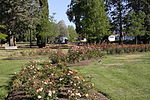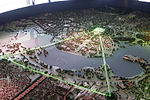National Rose Garden

The National Rose Gardens are a heritage-listed rose gardens located in Parkes, a suburb of Canberra, in the Australian Capital Territory of Australia. The rose gardens were added to the Australian Commonwealth Heritage List on 22 June 2004.The National Rose Gardens, conceived in 1926 and opened in 1933, were Australia's first national gardening project and were planned as a physical expression of the principle of cooperation between the Commonwealth and the States. In the development of the Gardens roses were contributed by all States in Australia. The Gardens were intended to provide an interest for all Australians in developing Canberra, the national capital, as a garden city. The Gardens demonstrate a distinctive early example of twentieth century public garden design in a formal style. In horticultural terms the Gardens have provided the opportunity to exhibit the best varieties of Australian grown and overseas roses in a favourable climate. Their location in front of the (then Provisional) Old Parliament House was planned to enhance the setting of the House. The Gardens are valued by visitors to Canberra as well as the local community for their aesthetic qualities.
Excerpt from the Wikipedia article National Rose Garden (License: CC BY-SA 3.0, Authors, Images).National Rose Garden
King George Terrace, Canberra Parkes
Geographical coordinates (GPS) Address Website Nearby Places Show on map
Geographical coordinates (GPS)
| Latitude | Longitude |
|---|---|
| N -35.303055555556 ° | E 149.13111111111 ° |
Address
House of Representatives Garden
King George Terrace
2600 Canberra, Parkes
Australia
Open on Google Maps









